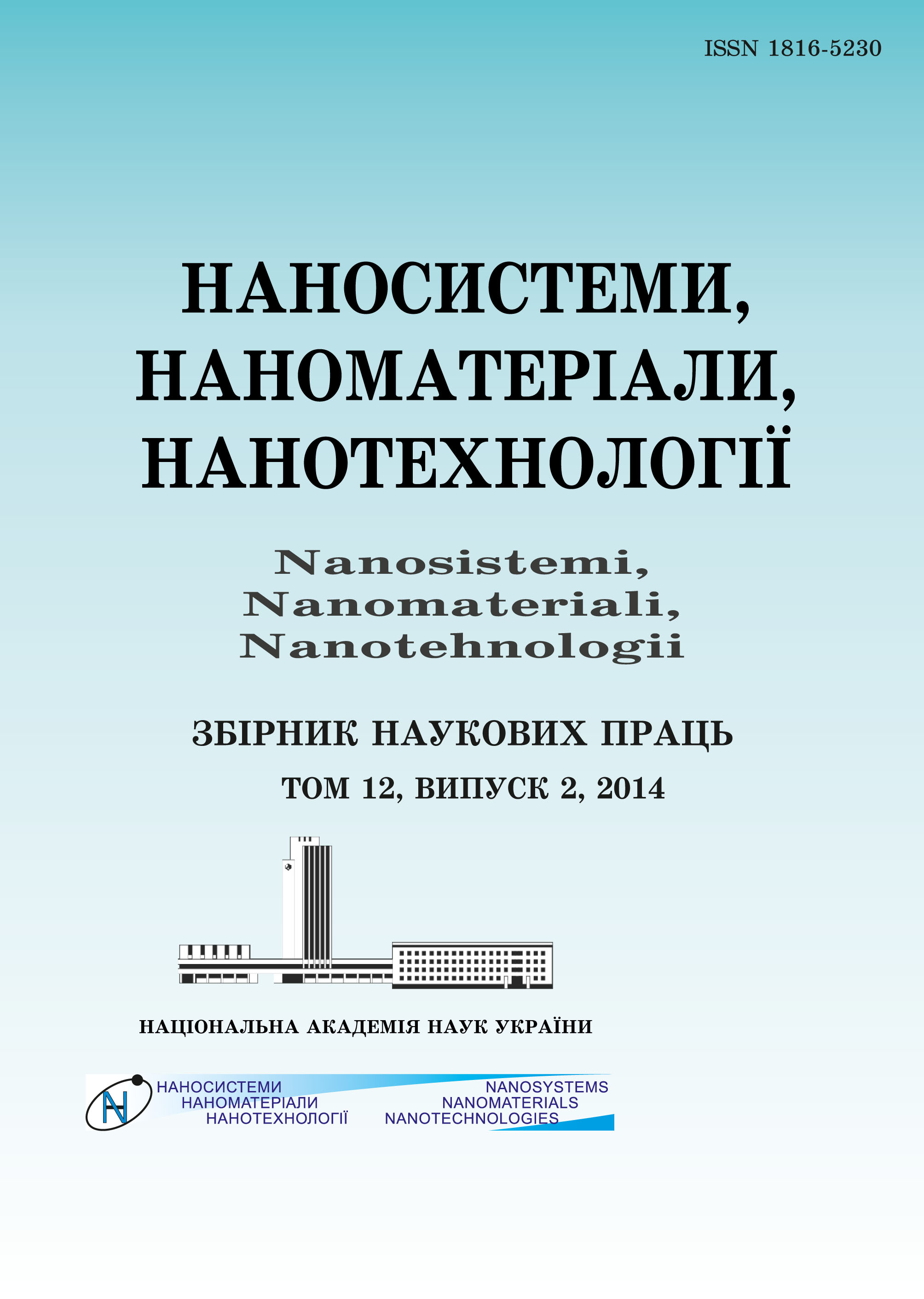|
|
|||||||||
 |
Year 2023 Volume 21, Issue 3 |
|
|||||||
|
|||||||||
Issues/2023/vol. 21 /Issue 3 |
M. S. KUKURUDZYAK
Study of the Morphology of Macroporous Si Obtained by Metal-Stimulated Etching with Au
605–616 (2023)
PACS numbers: 61.43.Gt,61.46.-w,68.37.Ps,68.55.J-,81.05.Rm,81.16.Nd,81.65.Cf
The article examines the morphology of porous silicon obtained by metal-assisted etching using Au. Selective Sirtle’s etchant with the composition of 100 cm3 HF, of 50 g CrO3, 120 cm3 H2O is chosen. The deposition of the Au film is carried out by means of the thermal sputtering in a vacuum. The thickness of the film is of 400–600 nm. In order to contact the actual Si with the etchant, photolithography is previously carried out to etch windows in Au. After the etching process, a chaotic macroporous structure is seen on the surface of the plates with a heterogeneous arrangement of pores of different sizes due to the high thickness of the film and, accordingly, a large amount of metal catalyst. We decide not to reduce the thickness of the metal layer, but to apply an Au film on the periphery of the active areas and demarcate the surface with gold undoped with silicon using photolithography. The morphology of porous n+-Si and p+-Si with the same etching duration is studied. On the n+-Si surface, a macroporous pyramid-like structure with a pore depth of 1–1.1 µm and a triangular pyramid side size of 5–8 µm is formed. A chaotic porous structure with smaller pores is observed on the p+-Si surface than on the n+-Si surface. The morphology of the surface is peak-like with a pore depth of up to 15 nm and a diameter of 100–800 nm. During simultaneous structuring on one plate of n+-Si and p-Si, heterogeneity of the pore size is observed at the boundary of the n+–p surface interface. We have also seen that, when mechanical impact is applied to the gold film from the reverse side of the substrate before etching by scratching, then, a projection of the scratch formed on the front side after etching is formed, formed by pores much smaller than the pores outside it. As found, the places, where dislocations appear on the silicon surface during selective etching in Sirtle’s solution with the use of Au, are much brighter, than when etching without a metal catalyst.
Key words: porous silicon, metal-assisted etching, selective etching.
https://doi.org/10.15407/nnn.21.03.605
References
- A. M. Mouafki, F. Bouaicha, A. Hedibi, and A. Gueddim, Eng. Technol. Appl. Sci. Res., 12, No. 2: 8354 (2022); https://doi.org/10.48084/etasr.4803
- L. A. Osminkina, S. N. Agafilushkina, E. A. Kropotkina, N. Y. Saushkin, I. V. Bozhev, S. S. Abramchuk, and A. S. Gambaryan, Bioact. Mater, 7: 39 (2022); https://doi.org/10.1016/j.bioactmat.2021.06.001
- V. A. Pilipenko, V. A. Gorushko, A. N. Petlitsky, V. V. Ponaryadov, A. S. Turtsevich, and S. V. Shvedov, Tekhnologiya i Konstruirovanie v Ehlektronnoi Apparature, 2–3: 43 (2013) (in Russian).
- R. Vercauteren, G. Scheen, J. P. Raskin, and L. A. Francis, Sens. Actuators A, 318: 112486 (2021); https://doi.org/10.1016/j.sna.2020.112486
- F. Zulkifli, R. Radzali, A. F. Abd Rahim, A. Mahmood, N. S. Mohd Razali, and A. Abu Bakr, Microelectron. Int., 39, No. 3: 101 (2022); https://doi.org/10.1108/MI-01-2022-0009
- A. A. Leonardi, M. J. lo Faro, and A. Irrera, Nanomaterials, 11, No. 2: 383 (2021); https://doi.org/10.3390/nano11020383
- X. Li and P. W. Bohn, Appl. Phys. Lett., 77, No. 16: 2572 (2000); https://doi.org/10.1063/1.1319191
- A. M. S. Salem, F. A. Harraz, S. M. El-Sheikh, and S. Ismat Shah, Mater. Sci. Eng. B Solid-State Mater. Adv. Technol., 262: 114793 (2020); https://doi.org/10.1016/j.mseb.2020.114793
- C. Y. Chen, C. S. Wu, C. J. Chou, and T. J. Yen, Adv. Mater., 20: 3811 (2008); https://doi.org/10.1002/adma.200702788
- M. S. Kukurudziak, Semicond. Phys. Quant. Electr. Optoelectr., 25, No. 4: 385 (2022); https://doi.org/10.15407/spqeo25.04.385
- M. S. Kukurudziak and E. V. Maistruk, IEEE 3rd KhPIWeek., 518 (2022); https://doi.org/10.1109/ŐĎČÍĺäĺë˙57572.2022.9916420
- M. S. Kukurudziak and E. V. Maistruk, Proc. SPIE 12126. Fifteenth International Conference on Correlation Optics, 121261V, 20 December 2021 (2021); https://doi.org/10.1117/12.2616170
- L. ˛. Karbivska, V. L. Karbivskii, V. A. Artemyuk, Z. D. Kovalyuk, Î. Ya. Kuznetsova, S. S. Smolyak, A. I. Sobolev, and V. V. Stonis, Metallofiz. Noveishie Tekhnol., 41, No. 3 (2019); https://doi.org/10.15407/mfint.41.03.0297
- M. S., Kukurudziak, J. Nano- Electron. Phys., 14, No. 4: 04015(6ńń) (2022); https://doi.org/10.21272/jnep.14(4).04015
- Z. Yue, H. Shen, and Y. Jiang, Appl. Phys. A, 114: 813 (2014); https://doi.org/10.1007/s00339-013-7670-y
- H. Ouyang, M. Christophersen, and P. M. Fauchet, phys. status solidi a, 202, No. 8: 1396 (2005); https://doi.org/10.1002/pssa.200461112
 This article is licensed under the Creative Commons Attribution-NoDerivatives 4.0 International License ©2003—2023 NANOSISTEMI, NANOMATERIALI, NANOTEHNOLOGII G. V. Kurdyumov Institute for Metal Physics of the National Academy of Sciences of Ukraine. E-mail: tatar@imp.kiev.ua Phones and address of the editorial office About the collection User agreement |